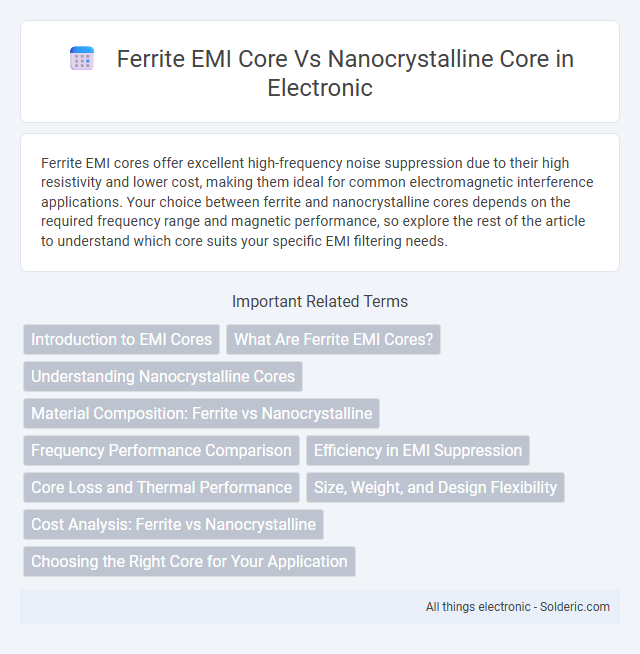Ferrite EMI cores offer excellent high-frequency noise suppression due to their high resistivity and lower cost, making them ideal for common electromagnetic interference applications. Your choice between ferrite and nanocrystalline cores depends on the required frequency range and magnetic performance, so explore the rest of the article to understand which core suits your specific EMI filtering needs.
Comparison Table
| Feature | Ferrite EMI Core | Nanocrystalline Core |
|---|---|---|
| Material Composition | Iron oxide mixed with other metals (ferrite) | Amorphous nanocrystalline metal alloys |
| Frequency Range | Effective up to 100 MHz | Effective from kHz up to several MHz |
| Magnetic Permeability | Moderate (1000-5000) | High (up to 100,000) |
| Core Loss | Higher losses at high frequencies | Low core losses, excellent efficiency |
| Temperature Stability | Good | Excellent, stable up to 200degC |
| Mechanical Strength | Brittle, ceramic-like | Ductile, flexible |
| Applications | EMI suppression, inductors, transformers | High-performance transformers, inductors, power electronics |
| Cost | Lower cost, widely available | Higher cost, specialized use |
Introduction to EMI Cores
EMI cores are essential components for suppressing electromagnetic interference in electronic circuits, enhancing signal integrity and device performance. Ferrite EMI cores, made from manganese-zinc or nickel-zinc ferrite materials, provide effective suppression at high frequencies due to their high permeability and low eddy current loss. Nanocrystalline cores offer superior magnetic properties, including higher saturation flux density and lower core loss, making them ideal for applications requiring compact size and improved EMI noise reduction.
What Are Ferrite EMI Cores?
Ferrite EMI cores are magnetic components made from ferrite material used to suppress electromagnetic interference (EMI) in electronic circuits by absorbing high-frequency noise. They exhibit high magnetic permeability and low electrical conductivity, which helps reduce signal distortion and improve electromagnetic compatibility (EMC). Compared to nanocrystalline cores, ferrite EMI cores typically offer higher impedance at higher frequencies but lower saturation flux density, making them ideal for applications requiring effective noise suppression in the MHz range.
Understanding Nanocrystalline Cores
Nanocrystalline cores offer superior magnetic properties compared to ferrite EMI cores, including higher permeability and lower core losses, which enhance efficiency in high-frequency applications. Their ultra-fine grain structure reduces energy dissipation and improves noise suppression in sensitive electronic circuits. Understanding your application's frequency and thermal requirements helps determine if nanocrystalline cores provide the optimal performance over traditional ferrite alternatives.
Material Composition: Ferrite vs Nanocrystalline
Ferrite EMI cores are composed primarily of iron oxide combined with metallic elements like manganese and zinc, offering high electrical resistivity and magnetic permeability ideal for suppressing high-frequency electromagnetic interference. Nanocrystalline cores consist of ultra-fine grain structures of iron-based alloys with silicon and boron, providing superior magnetic properties such as higher permeability and lower core losses across a broader frequency range. Your choice between ferrite and nanocrystalline material composition impacts efficiency and performance in EMI suppression, especially at varying frequencies and temperature conditions.
Frequency Performance Comparison
Ferrite EMI cores excel in high-frequency applications typically ranging from 30 kHz to several hundred MHz due to their low core loss and high permeability, making them ideal for noise suppression in switching power supplies and RF circuits. Nanocrystalline cores outperform ferrite cores at high frequencies above 1 MHz, offering significantly lower core losses, higher saturation flux density, and superior magnetic permeability, which enhances performance in transformers and inductors within high-frequency power electronics. Your choice between ferrite and nanocrystalline cores should consider the operating frequency range and efficiency requirements to optimize electromagnetic interference suppression.
Efficiency in EMI Suppression
Ferrite EMI cores provide effective suppression of high-frequency electromagnetic interference with moderate permeability and saturation levels, making them suitable for general EMI reduction tasks. Nanocrystalline cores offer superior efficiency in EMI suppression due to their higher magnetic permeability and low core losses, enabling better attenuation of a wider frequency range and improved performance in compact electronic devices. Choosing your core type depends on balancing cost, frequency range, and suppression efficiency specific to your application.
Core Loss and Thermal Performance
Ferrite EMI cores exhibit higher core loss at elevated frequencies, leading to increased heat generation and limited thermal performance, making them less efficient in high-frequency applications. Nanocrystalline cores offer significantly lower core loss due to their superior magnetic properties, resulting in improved thermal stability and reduced heat buildup during operation. Choosing nanocrystalline cores for your EMI filtering needs ensures enhanced efficiency and better long-term thermal management under demanding conditions.
Size, Weight, and Design Flexibility
Ferrite EMI cores are generally larger and heavier due to their ceramic composition, making them less suitable for compact designs, while nanocrystalline cores offer significantly smaller size and reduced weight, enhancing design flexibility in space-constrained applications. Nanocrystalline materials exhibit higher magnetic permeability and better saturation flux density, allowing for more efficient EMI suppression with fewer turns and compact coil assemblies. Your choice of core impacts the overall electromagnetic interference performance and mechanical integration, favoring nanocrystalline cores for advanced, lightweight, and miniaturized electronic designs.
Cost Analysis: Ferrite vs Nanocrystalline
Ferrite EMI cores generally offer a cost-effective solution with lower material and manufacturing expenses compared to nanocrystalline cores, making them suitable for budget-sensitive applications. Nanocrystalline cores, while more expensive due to advanced alloy composition and complex production processes, provide superior magnetic properties such as higher permeability and lower core losses, which can justify the higher initial investment for high-performance needs. Evaluating your application's performance requirements against budget constraints will help determine if the premium cost of nanocrystalline material is warranted over the economical ferrite alternative.
Choosing the Right Core for Your Application
Ferrite EMI cores provide excellent high-frequency noise attenuation and cost-efficiency for standard electromagnetic interference suppression in power cables and electronic circuits. Nanocrystalline cores offer superior magnetic permeability, lower core loss, and enhanced performance at higher frequencies, making them ideal for high-precision and high-frequency power applications such as transformers and inductors. Selecting between ferrite and nanocrystalline cores depends on factors like frequency range, efficiency requirements, thermal stability, and budget constraints.
Ferrite EMI core vs Nanocrystalline core Infographic

 solderic.com
solderic.com